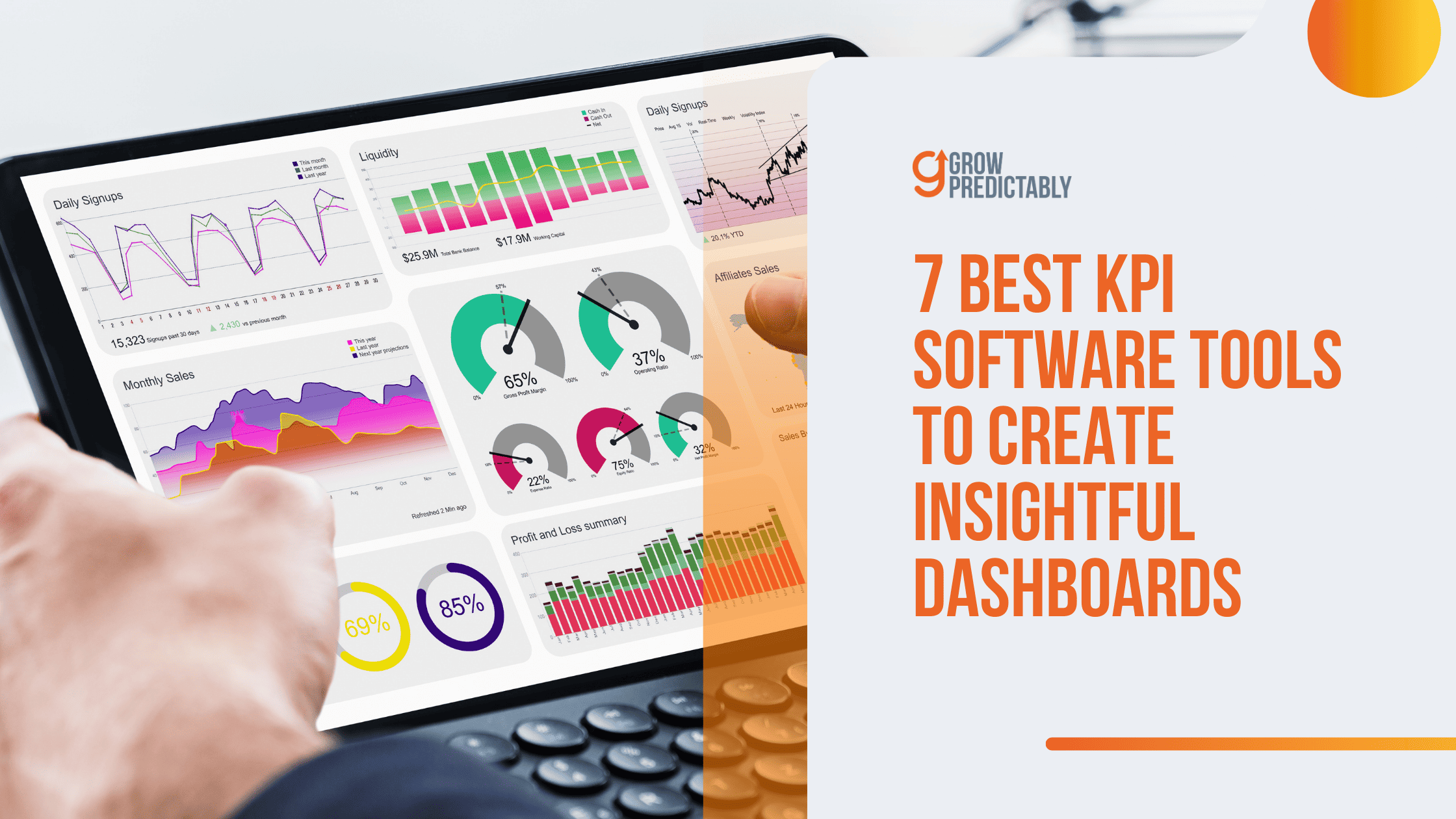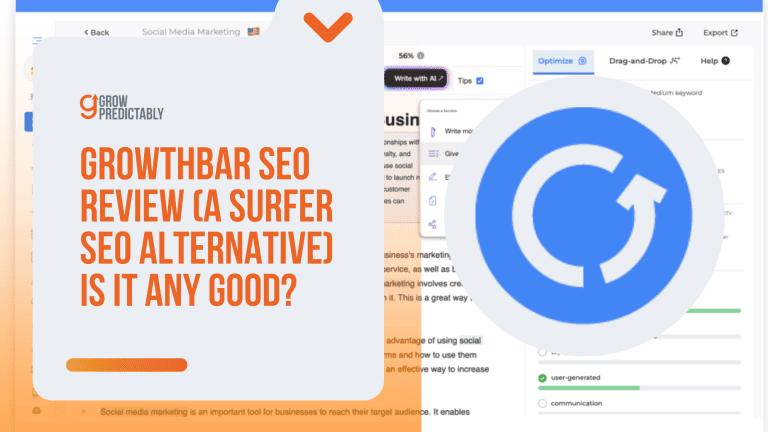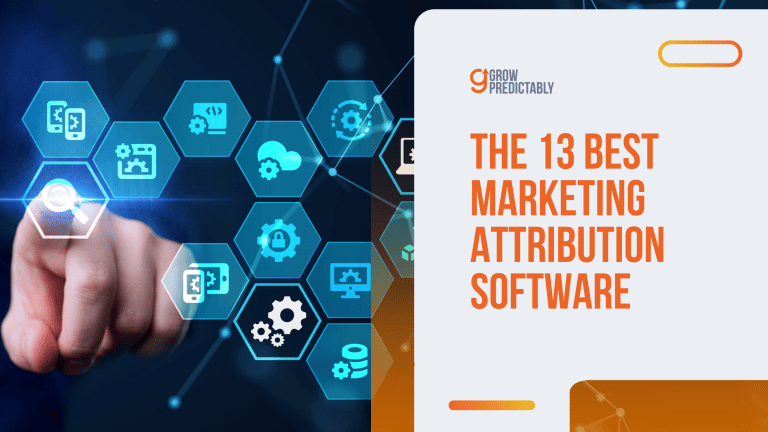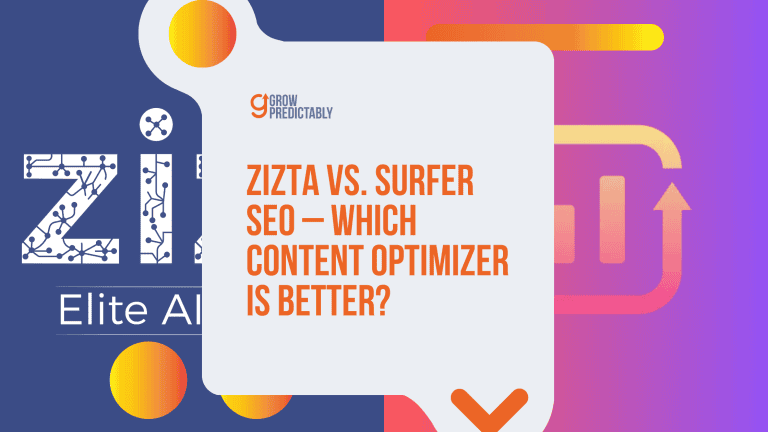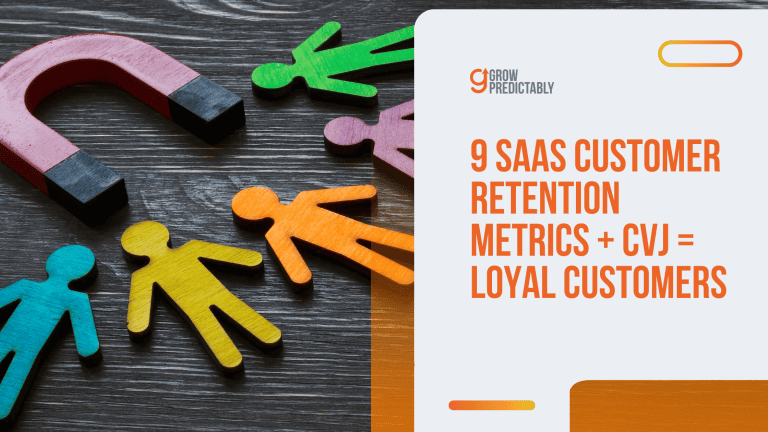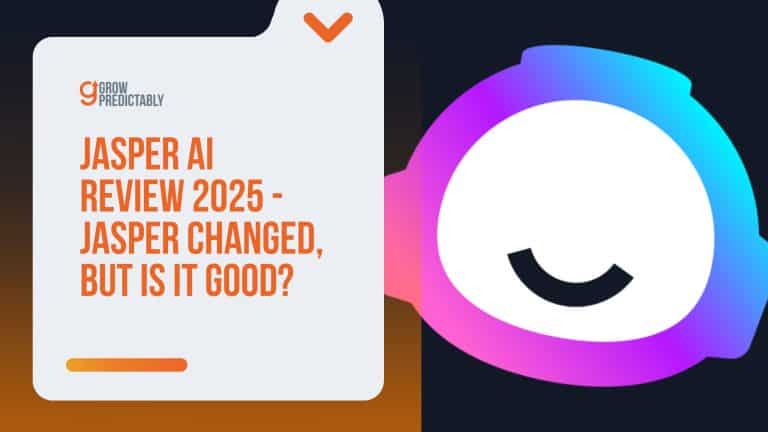7 Best KPI Software Tools to Create Insightful Dashboards in 2025
A significant 95% of the world’s top marketers are in agreement: For a business to resonate, KPIs need to align with wider business objectives. The first step? Managing your KPIs effectively.
Have you ever wished to design insightful dashboards but felt lost? Do you find the variety of KPI software options overwhelming?
Stay calm. This review is here to simplify things for you. In this blog post, I’ll introduce you to seven of the most effective KPI software options that will be making headlines in 2025.
Whether you’re a small business owner or a marketer, these tools are designed to provide you with the insights you need to make informed decisions and push your business forward.
But before we delve into our top seven KPI software picks, let’s first understand what KPI software can actually do for you. Spoiler alert: It’s more than just a number-crunching machine!
What is KPI software?
KPI software or KPI dashboards are a special kind of business intelligence tool designed to help you analyze business data.
Think of KPIs as a yardstick for how well your business is performing in relation to its set goals. Measuring your KPIs is just one of the many ways to leverage digital analytics fully.
KPI dashboards often include metrics like revenue, profit, customer satisfaction, and employee productivity.
This type of software is a business’s best friend, aiding in pinpointing areas that need adjustments. It usually comes equipped with a dashboard builder, letting you design custom KPI dashboards tailored to your organization’s priorities.
How does it work?
KPI tools are like data detectives, gathering business information from complex data, including financial reports, CRM systems, surveys, and web analytics tools.
This collected business data is then scrutinized and presented in easy-to-read dashboards and reports. Businesses can use these visual aids to monitor their KPIs over time and pinpoint areas that could do with a boost.
Typically, the software comes packed with a host of features such as user-friendly dashboard builders (think drag-and-drop simplicity), data visualization tools for a clear picture of your performance, and real-time alerts to keep you on your toes.
Some KPI tools also offer predictive analytics features that help companies forecast future performance.
The market is brimming with a variety of KPI dashboard tools that organizations can cherry-pick based on their needs.
These tools are like diligent data collectors, amassing information in real-time, morphing it into visually appealing dashboards, and streamlining reporting by letting users glean the information they need from just one tool. Thanks to instant alerts, users are kept in the loop about any performance shifts, enabling swift action.
Embracing KPI software means businesses can wave goodbye to heaps of analytical work. Now, to jog our memories about the perks of using KPI software, let’s revisit the common benefits it offers.
The Common Benefits of Using Key Performance Indicator (KPI) Tools
There are many benefits of using KPI visualization tools. Here are some of the most important ones:
- Helps Evaluate Business Performance
- Easy Assessment of ROI
- Offers Opportunities for Business Growth
- Provides Measurable Results
- Data-Backed Decisions
- Improved Customer satisfaction
- Increased Revenue and Profitability
- Saves Money
- Provide a Competitive Advantage
- Proactive Problem Solving
- Extract Meaningful Insights
1. Helps evaluate business performance
A key upside of a KPI tool is its ability to help companies dissect and assess their business data – think of it as your very own Google Analytics.
By keeping an eagle eye on KPIs, organizations can spot the areas crying out for improvement and implement the needed changes.
What’s more, this software gives firms a chance to measure their performance against industry peers. This vital intel lets them know their standing in the competitive landscape and highlights the tweaks needed to climb up the industry ladder.
2. Easy assessment of ROI
Another fantastic perk of KPI is its ability to simplify the evaluation of different business activities’ return on investment (ROI).
By keeping tabs on KPIs, businesses can identify which actions are bringing in the biggest returns and tweak their strategies for maximum impact.
This ensures organizations allocate their resources smartly, paving the way for improved profit growth.
Moreover, the KPI dashboard isn’t just for big-picture stuff. It can also track individual employee performance. By setting goals and tracking progress, organizations can spot their star performers and spur them on to keep up the good work.
3. Offers opportunities for business growth
Beyond offering insights to boost efficiency, a KPI tool also opens doors for business expansion.
For instance, by analyzing customer data, business owners can spot fresh market opportunities and zero in on new customers.
KPI tools are also handy for tracking progress and business performance over time, aiding in goal-setting and success measurement. This software is a secret weapon for organizations looking to stay ahead of the curve and boost their bottom line.
4. Provides measurable results
Another awesome advantage of using KPI tools is their ability to deliver quantifiable results, much like Google Analytics. This is key as it empowers companies to track their progress and witness the ripple effects of their actions.
Having measurable results also comes in handy when plotting future strategies. By scrutinizing past data, organizations can make more informed decisions about resource allocation, paving the way for a more efficient and effective operation.
With measurable results, businesses are able to quantify information about their customers, the results of the actions that they’ve so far taken in the business, and more.
KPI tool can help to save time and money by making it easier to measure progress and make data-driven decisions.
5. Data-backed decisions
KPI tools tap into data sources that can be leveraged to make savvy decisions about different facets of your business.
For instance, ever wondered which products are flying off the shelves and which ones could use a little TLC? A deep dive into customer data sources can answer that!
What’s more, KPI data can act as your business’ progress tracker, helping you stay on track with your goals and objectives. Falling behind? No worries – the data will flag it up, giving you a chance to course-correct. Now, isn’t that a tool worth having in your business arsenal?
6. Improved customer satisfaction
Top-notch KPI tools can be a game-changer in enhancing customer satisfaction. By monitoring customer data, businesses can zero in on areas ripe for a revamp.
Plus, KPIs can be leveraged to whip up dashboard reports, revealing how well they’re hitting their customer satisfaction targets.
After all, aren’t customers the lifeblood of any business? With a trusty KPI program, organizations can rest assured they’re making decisions that’ll boost customer contentment. Now, isn’t that a win-win situation?
7. Increased revenue and profitability
Another plus of using data dashboard software? It’s a handy helper in boosting an organization’s revenue and profitability.
The software serves as a guide, letting firms track their sales and performance data. This goldmine of info can then steer decisions about pricing, product development, and marketing strategies.
When businesses get a clearer view of their numbers, they’re more equipped in making data-backed decisions. And when decisions are backed by data, it is more likely to succeed. Therefore impacting profitability.
By understanding their sales data and other data sources, corporates can make changes to their operations to increase revenue and profitability (e.g. marketing attribution).
8. Saves money
One of the top perks of KPI dashboard software? It’s a real money-saver. The software takes care of tasks like data collection and analysis, freeing up businesses to zero in on more pressing matters.
Plus, the KPI program is your go-to for data-driven decisions, helping steer clear of expensive missteps. Now, isn’t that a neat way to keep your budget in check while making smart choices?
9. Provide a competitive advantage
Another plus of using a dedicated platform for tracking your KPIs? It can give you a leg up on the competition.
The software is your go-to for collecting and analyzing data, paving the way for improved processes and smarter decision-making. This could be just the ticket to outsmarting your rivals.
What’s more, the software can help you delve into customer behavior and preferences. Armed with this info, you’re set to craft targeted marketing campaigns and step up your customer service game. Now, isn’t that a recipe for success?
10. Proactive problem solving
KPI dashboard software is not just a tool. It’s your business’s proactive problem solver. By tapping into varied data sources, businesses can spot potential hiccups before they morph into major headaches, dodging costly errors and disruptions.
And that’s not all! The data harvested by the KPI program can be a catalyst for process improvement. By dissecting this data, firms can pinpoint areas ripe for change, boosting efficiency and productivity. Now, who wouldn’t want that kind of power at their fingertips?
11. Extract meaningful insights
KPI tools help you quickly extract meaningful insights from your data.
By visualizing your data in an easy-to-understand format, KPI software makes it easy to identify patterns and trends.
As a result, you can make more informed decisions about where to allocate resources and how to improve your business processes.
KPI software can help you track progress over time and compare different scenarios. This can be invaluable for making strategic decisions about the future of your business. With KPI software, you can gain a competitive edge by having the latest information at your fingertips.
Make sure to investigate the different KPI software options available so that you can find the tool that best meets your needs.
As we inch closer to our seven picks of the best KPI tools on the market today, let’s briefly discuss what one should look for in a KPI tool for the best results.
The Features of a Good KPI Tool
Below are some of the most common features that you will find in dashboard software:
- Customizable Dashboards
- Data Integration
- Reporting
- Data Visualization
- Web Accessibility
- Automatic Alerts
- Trend Spotting
1. Customizable Dashboards
A lot of business leaders rely on KPI dashboard software to gauge their success. This software usually includes a dashboard builder, letting businesses craft their own unique dashboards.
These dashboards are super customizable and can be tweaked to align with each organization’s needs through a drag-and-drop functionality.
Some tools even throw in a variety of pre-built dashboards that businesses can use as a launchpad. These dashboards can be further customized to meet the distinctive needs of each organization.
2. Data Integration
KPI platforms typically pack features that enable businesses to gather info from diverse data sources like financial reports, CRM systems, surveys, and web analytics tools.
This data then takes center stage in the form of dashboards and reports.
Data integration features often include an API that lets firms link the software to their other business systems. This ensures all your data is gathered in one central hub, and organizations can get a holistic view of their performance.
Some KPI tools even offer a data warehouse for storing your data. This keeps all your data under one roof and makes report generation a breeze.
3. Reporting
Regardless of the analytics solution you’re using, standard reporting features usually include a variety of report templates that businesses can use to track KPIs.
These reports can be customized to accommodate organizations’ specific data and info.
What’s more, many KPI dashboard software tools can schedule reports to be generated and emailed to select users regularly.
This could be a surefire way to ensure everyone in the company stays in the loop about the KPIs that matter most.
Reporting is a must-have feature of any KPI dashboard software as it allows for tracking progress over time and pinpointing areas needing a boost.
4. Data Visualization
Data visualization features enable businesses to showcase their complex data in a variety of formats, like graphs, charts, and maps. Data visualizations simplify the process of identifying trends and patterns in their data.
Some KPI tools also offer a selection of pre-built dashboard templates that organizations can use to kickstart their data visualization. These templates can be customized to fit the unique needs of the business.
5. Web Accessibility
With cloud-based platforms, users can access their dashboards from anywhere, even from mobile devices. This is an invaluable feature for companies with remote employees or those working from different locations.
Additionally, many KPI tools offer mobile apps that let users view their dashboards on the go. This is a convenient way for busy professionals to stay on top of their KPIs.
Web-based and mobile access are crucial features in a KPI tool. The crème de la crème platforms will offer both.
6. Automatic Alerts
Automatic alerts are key to keeping your finger on the pulse of your business.
The best software will allow you to set thresholds for each metric and send an alert whenever those thresholds are exceeded. This way, you can spring into action before it’s too late.
The alerts can be sent to your email, mobile phone, or chat client for instant action.
These are especially crucial for time-sensitive KPIs like support ticket response times or website uptime.
7. Trend Spotting
This feature is a boon for companies wanting to stay ahead of the game. With trend spotting, organizations can keep tabs on industry changes and tweak their strategies accordingly.
This can help sidestep costly mistakes and seize opportunities.
KPIs can aid organizations in a myriad of ways. By providing insights into KPIs, businesses can make informed decisions that bolster their bottom line.
If you’re on the hunt for a way to supercharge your business’s performance, consider investing in KPI reporting tools.
Now that we’ve covered the definition, benefits, and key features that make up the best KPI software, here are the seven top KPI software in 2025 that businesses should use.
The 7 Best KPI Software Tools In The Market
Finding the right KPIs for your business is essential to monitor and track your progress and growth. To help you get started, here are 7 of the best KPI software tools in the market today that will help you capture meaningful insights.
Here is a list of the best to consider in 2025:
1. Domo
Domo is a powerful data experience platform designed to help you manage your Key Performance Indicators (KPIs) effectively. It enables you to put data to work, moving beyond basic charts and graphs to data experiences that fuel insights and prompt action when it matters most.
Domo is built with a user-centric approach, making it easy for anyone to use while offering advanced technical team capabilities. It also offers many features, such as data warehousing, ETL, and data mining.
With Domo, you can drive your business forward, leveraging fresh data and provocative insights to multiply your business impact.
What I like/dislike

2. Tableau
Tableau is a visual analytics software designed to help you manage your Key Performance Indicators (KPIs) effectively. It’s built to help people see and understand data, transforming how you use data to solve problems.
Tableau is trusted by organizations of all sizes to help them become more data-driven. With its intuitive products, data analysis becomes about asking questions, not learning software.
Tableau provides limitless data exploration and a drag-and-drop interface that makes it easy to create beautiful visualizations. As a trusted partner, Tableau helps organizations accelerate innovation, improve operations, and better serve their customers by embracing a Data Culture.
What I like/dislike

3. Scoro
Scoro is a comprehensive work management software designed for individuals who need to manage their Key Performance Indicators (KPIs). It’s built for service businesses that want to escape disjointed systems, unpredictable workloads, and shrinking margins.
Scoro allows you to easily track KPIs in one place and see how your team members are doing against your goals. It helps you plan and forecast your resources, ensuring balanced workloads and proactive decision-making.
With Scoro, you can track profitability in real time, understanding which clients, projects, services, or teams are profitable and which are eating into your margins.
What I like/dislike

4. SimpleKPI
SimpleKPI is a user-friendly KPI software designed for individuals who need to manage their Key Performance Indicators (KPIs). It provides a platform to track your KPIs, metrics, and business data with insightful dashboards and reports.
SimpleKPI offers a unique simplicity amongst KPI software, making data management uncomplicated. It comes with features for real-time monitoring, reporting for sharing and collaboration, and analysis features for understanding the causes behind data fluctuations.
With SimpleKPI, you can track individuals, teams, and departments and use easy-to-use management tools to keep your data organized. It also provides a wide range of pre-built templates that can be used to create dashboards quickly.
What I like/dislike

5. Klipfolio
Klipfolio PowerMetrics is a business dashboard and analytics software designed for individuals who need to manage their Key Performance Indicators (KPIs). It allows you to connect to the data sources you use every day and create dashboards that everyone on your team can understand and appreciate.
Klipfolio provides centralized access to shared, up-to-date data for decision-making, allowing you to combine data from different sources and metrics in one view.
It offers customizable, presentation-ready data visualizations and dashboards and facilitates sharing these dashboards with colleagues for unified decision-making.
What I like/dislike

6. HubSpot
HubSpot’s KPI Software is a comprehensive tool designed for individuals who need to manage their Key Performance Indicators (KPIs). It allows you to build dashboards, create automated reporting, and track KPIs to measure your teams’ performance and drive improvement over time.
The software offers visually appealing KPI dashboards that are easy to create and understand. It also provides sales forecasting to help predict the future of your staff accordingly.
With HubSpot’s KPI Software, you can enjoy data clarity and consistency across every feature within the HubSpot ecosystem.
What I like/dislike

7. Sisense
Sisense is a comprehensive data analytics platform designed for individuals who need to manage their Key Performance Indicators (KPIs). It allows you to infuse data everywhere you work, offering seamless and simplified ways to connect, analyze, explore, and collaborate.
It also offers cross-cloud flexibility and cloud-agnostic deployment and integration capabilities with AWS, Snowflake, Google, and Microsoft. Plus, if you need more advanced features, Sisense has a wide range of plugins that you can use to extend the software’s functionality.
What I like/dislike

FAQs
If you’re starting to learn about KPIs, you probably have some questions that you want to explore. Here, we’ll answer a few of the most frequently asked questions about KPIs and KPI tools.
In Summary
Every software tool we’ve mentioned above is a fantastic pick for organizations keen on keeping their KPIs on track.
They’re packed with a smorgasbord of features, a breeze to use, and come with insightful dashboards that can steer you toward smarter decisions.
So, ready to take your business performance up a notch? Pick the one that meshes with your needs, and get started today. After all, why wait to start improving?

